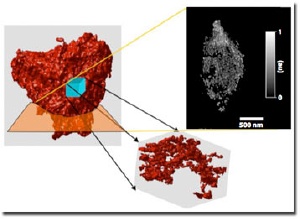Jul 30 2008
Researchers have created a 3D image of a material referred to as "liquid
smoke."
 Section and isosurface rendering of a 500-nanometer cube from the interior of the 3D volume. The foam structure shows globular nodes that are interconnected by thin beam-like struts. Approximately 85 percent of the total mass is associated with the nodes, and there is no evidence of a significant fraction of dangling fragments.
Section and isosurface rendering of a 500-nanometer cube from the interior of the 3D volume. The foam structure shows globular nodes that are interconnected by thin beam-like struts. Approximately 85 percent of the total mass is associated with the nodes, and there is no evidence of a significant fraction of dangling fragments.
Aerogel, also known as liquid smoke or “San Francisco fog,” is
an open-cell polymer with pores smaller than 50 nanometers in diameter.
For the first time, Lawrence
Livermore and Lawrence Berkeley scientists have peered into this material
and created three-dimensional images to determine its strength and potential
new applications.
Aerogel is a form of nanofoam, an engineered material designed for high strengh-to-weight
ratio. Such nanofoam structires are also present in the fields of geology, phospholipids,
cells, bone structure, polymers and structural materials, wherever lightness
and strength are needed.
These mesoporous (2-50 nanometer-sized pores) crystalline materials can be
used as catalysts for cleaner fuels and for the diffusion of water and oil in
porous rocks. The structure and diffusion properties of nanofoams are determined
by their structure.
Aerogels have the highest internal surface area per gram of material of any
known materials because of its complicated, cross-linked internal structure.
They also exhibit the best electrical, thermal and sound insulation properties
of any known solid. It’s not easy to see inside aerogel to determine the
topology and structure at nanoscale-length scales because the smallest pore
is normally too small to be observed internally by any conventional microscope.
But Livermore scientist Anton Barty and Lawrence Berkeley researcher and former
LLNL scientist Stefano Marchesini were determined. They inverted coherent X-ray
diffraction patterns to capture the three-dimensional bulk lattice arrangement
of a micron-sized piece of aerogel.
“By imaging an isolated object at high resolution in three dimensions,
we’ve opened the door to a range of applications in material science,
nanotechnology and cellular biology,” Barty said.
For about 20 years, Livermore has developed and improved aerogels for national
security applications, synthesized electrically conductive inorganic aerogels
for use as supercapacitors, and as a water purifier for extracting harmful contaminants
from industrial waste or for desalinizing seawater, and even used aerogel to
capture stardust particles during NASA’s Stardust mission.
The new research shows that the lattice structure within aerogel is weaker
than expected. The researchers saw a structure made up of nodes connected by
thin beams.
“This blob and beam structure explains why these low-density materials
are weaker than predicted and explains the high mass scaling exponent seen in
the materials,” Barty said.
In the future, the 3D analysis could be applied to other porous materials and
could help modeling filtration problems such as oil and water in minerals, Barty
said.
Other Livermore researchers include Aleksandr Noy, Stefan Hau-Riege, Alexander
Artyukhin, Ted Baumann, James Stolken, Tony van Buuren, John Kinney and former
LLNL researcher Henry Chapman, who is now at the Centre for Free Electron Laser
Science, DESY, in Hamburg, Germany.
The team used the Advanced Photon Source at Argonne National Laboratory for
the experiments.
The research appears in the July 29 issue of the journal Physical Review Letters.